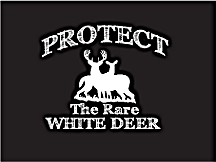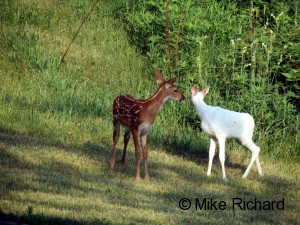
White Deer Culture and History
White deer in myths and legends
 From Advocacy For Animals: http://advocacy.britannica.com/blog/advocacy/2008/12/the-white-deer-at-the-seneca-army-depot/
From Advocacy For Animals: http://advocacy.britannica.com/blog/advocacy/2008/12/the-white-deer-at-the-seneca-army-depot/
In certain cultures around the world, European, Native American, and Asian, there have been stories and myths told about white deer.
In European mythology magical animals are striking in appearance owing to their supernatural shape, color, speed, and power; a frequent attribute of those animals is an unnatural white color.
In Celtic mythology the pursuit of supernatural animals is a common theme. The white stag or hart often appears in the forests around King Arthur’s court, sending the knights on adventures against gods and fairies. One fable relates how King Arthur arrived at Sir Pellinore’s well, a magical site, without his hunting party or his horse after pursuing a white deer. The white stag was also the heraldic symbol of England’s King Richard II.
In Hungarian mythology a white stag led the brothers Hunor and Magar to settle in Scythia and to establish the Hun and Magyar people.
In Native American mythology there is the Chickasaw legend, Ghost of the White Deer. There is also a Lenape legend about white deer that predicts that when a pair of all-white deer is seen together, it is a sign that the indigenous peoples of the Dawnland will all come together and lead the world with their wisdom.
Many tribes and indigenous peoples throughout the world have similar myths. The Seneca, Roanoke, Algonquin, Nanticoke, and Pocomoke tribes all relate sightings of the Great White Deer.
In Kamakura, Japan, the Engakuji Temple, which was founded in 1282, is the head of a branch school of the Rinzai sect of Zen Buddhism. There a herd of divine white deer are said to have emerged from a cave to listen to the sermon of the temple’s founder the day it opened.
The white stag in British myth and legend
From Mail Online: http://www.dailymail.co.uk/news/article-1233644/Pictured-Mythical-white-stag-forests-Gloucestershire.html
White stags have long been associated with mythology and legend, an elusive yet magnificent beast.
King Arthur was left frustrated by his attempts to capture one, as were the Kings and Queens of Narnia, who chased the creature through the woods and found themselves tumbling out of a wardrobe.
………………………..
White deer, closely identified with unicorns, have been potent figures in the mythology of many cultures.
It is said to be bad luck to kill one. According to the Scots legend, in 1128, David I, King of Scotland decided to go hunting on the Feast Day of the Holy Rood, against the wishes of his priest. While hunting he saw a huge white stag, or “hart”, and while giving chase he was thrown from his horse.
The white hart charged forward to kill him, so David – son of Malcolm Canmore and St. Margaret – called on God to save him. As the king grasped the hart’s antlers, they miraculously turned into a large cross, and the beast raised its head and vanished. Inspired by his vision, King David built a shrine to the Holy Rood – meaning Holy Cross – on the spot where the miracle occurred.
The ruin of Holyrood Abbey can still be seen today, at the foot of the Royal Mile next to Holyrood Palace. The White Hart Inn in Edinburgh’s grassmarket, reputedly the oldest pub in the capital, took its name from the legend.
The Celts considered white stags to be messengers from the “other world” and their appearance was said to herald some profound change in the lives of those who encountered them.
In the Chronicles of Narnia, the White Stag is fabled to grant wishes to whoever catches him. And in the Arthurian legend, the white stag is the creature that can never be caught. King Arthur’s repeatedly unsuccessful pursuit of the white stag represents mankind’s quest for spiritual knowledge.
In Christianity a white stag was said to be instrumental in the conversion of the martyr Saint Eustace after he saw a vision of the animal that told him he would suffer for Christ.
White deer in Native American culture
White deer have been respected and revered throughout human history. Native Americans especially considered the white deer sacred and a symbol of spirit. Here are some stories of these white deer:
Ghost of the White Deer; a Chickasaw Legend
http://www.firstpeople.us/FP-Html-Legends/GhostoftheWhiteDeer-Chickasaw.html
The White Deer of Onota
http://www.sacred-texts.com/ame/lol/lol125.htm
Ojibway Story of the White Deer, Waabi Waawashkeshi
A story related by a Lac du Flambeau elder tells of creation and the assignment of roles as leaders to the different animals. The role of the white deer is to remind us of our spirituality.
“This white one represents the sacredness of all living things and they should be left alone, never hunted or bothered. When we see them, we should take notice of our own spirituality and think about where we are with it.”
(Complete story in: White Deer; Ghost of the Forest by Jeff Richter and John Bates.)
Viginia Dare: Lost to History but Found in White Deer Legend
Virginia Dare, the first English child to be born in the New World, disappeared without a trace from the island of Roanoke in present day North Carolina. Theories abound as to what may have happened to the “Lost Colony” and Virginia Dare, including these stories of a mysterious white deer:
http://www.boyscouttrail.com/content/story/white_deer_named_virginia_dare-3.asp
http://www.northcarolinaghosts.com/coast/virginia-dare-white-doe.php

